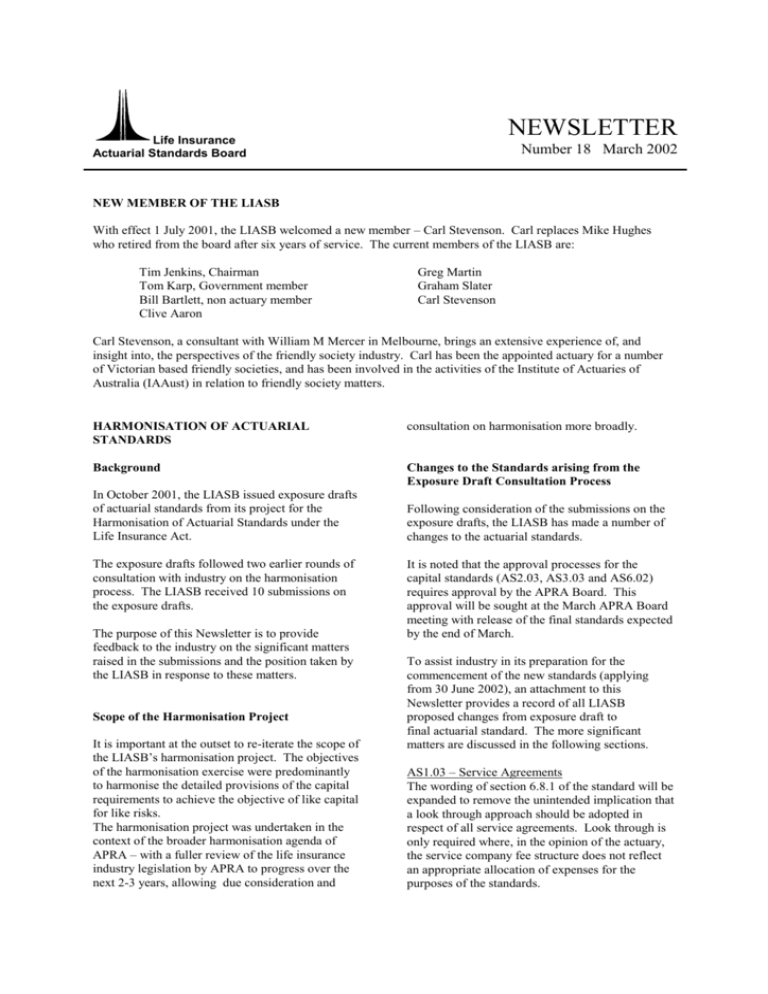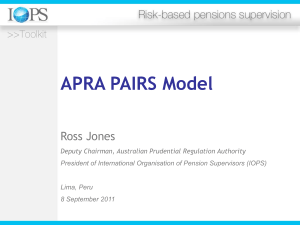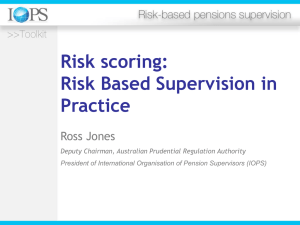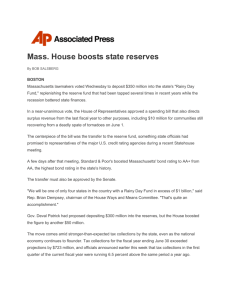LIASB Number 18 March 2002
advertisement

NEWSLETTER Life Insurance Actuarial Standards Board Number 18 March 2002 NEW MEMBER OF THE LIASB With effect 1 July 2001, the LIASB welcomed a new member – Carl Stevenson. Carl replaces Mike Hughes who retired from the board after six years of service. The current members of the LIASB are: Tim Jenkins, Chairman Tom Karp, Government member Bill Bartlett, non actuary member Clive Aaron Greg Martin Graham Slater Carl Stevenson Carl Stevenson, a consultant with William M Mercer in Melbourne, brings an extensive experience of, and insight into, the perspectives of the friendly society industry. Carl has been the appointed actuary for a number of Victorian based friendly societies, and has been involved in the activities of the Institute of Actuaries of Australia (IAAust) in relation to friendly society matters. HARMONISATION OF ACTUARIAL STANDARDS consultation on harmonisation more broadly. Background Changes to the Standards arising from the Exposure Draft Consultation Process In October 2001, the LIASB issued exposure drafts of actuarial standards from its project for the Harmonisation of Actuarial Standards under the Life Insurance Act. The exposure drafts followed two earlier rounds of consultation with industry on the harmonisation process. The LIASB received 10 submissions on the exposure drafts. The purpose of this Newsletter is to provide feedback to the industry on the significant matters raised in the submissions and the position taken by the LIASB in response to these matters. Scope of the Harmonisation Project It is important at the outset to re-iterate the scope of the LIASB’s harmonisation project. The objectives of the harmonisation exercise were predominantly to harmonise the detailed provisions of the capital requirements to achieve the objective of like capital for like risks. The harmonisation project was undertaken in the context of the broader harmonisation agenda of APRA – with a fuller review of the life insurance industry legislation by APRA to progress over the next 2-3 years, allowing due consideration and Following consideration of the submissions on the exposure drafts, the LIASB has made a number of changes to the actuarial standards. It is noted that the approval processes for the capital standards (AS2.03, AS3.03 and AS6.02) requires approval by the APRA Board. This approval will be sought at the March APRA Board meeting with release of the final standards expected by the end of March. To assist industry in its preparation for the commencement of the new standards (applying from 30 June 2002), an attachment to this Newsletter provides a record of all LIASB proposed changes from exposure draft to final actuarial standard. The more significant matters are discussed in the following sections. AS1.03 – Service Agreements The wording of section 6.8.1 of the standard will be expanded to remove the unintended implication that a look through approach should be adopted in respect of all service agreements. Look through is only required where, in the opinion of the actuary, the service company fee structure does not reflect an appropriate allocation of expenses for the purposes of the standards. AS 2.03/AS3.03 – Reinsurance Arrangements Section 3.3.2 establishes requirements in respect of the treatment of retrocessions by a specialist reinsurer to its overseas parent for the purposes of the capital standards. The requirements rely on a concept of the investment grade rating of the parent company. In response to industry concerns with the lack of definition of the concepts used, a more detailed approach will be introduced to define the rating grade of the parent entity. The basis adopted is consistent with that recently introduced by APRA in its standards for the general insurance industry. AS2.03 – Disability Assumption The limitations of the defined table in representing the variety of product and experience in the Australian disability market in practice, was highlighted in industry submissions. While the suggestion that greater reliance be placed on best estimate assumptions will be accepted by the LIASB, given the desire for a prescriptive basis for the solvency standard, a minimum underpin will also be prescribed. This minimum will be linked to the defined table, but the prescribed percentage of defined table will be made more responsive to a particular company’s own experience in order to better address the identified limitations. AS6.02 – Expense Reserve Harmonisation of the expense reserve component of the capital standards presented some practical difficulties given the different purposes which underly the existing reserves in their respective regimes. In the regime for life insurers other than friendly societies, the expense reserve related to acquisition expenses of the life business only. In a friendly society the reserve was based on total expenses, and those related to life business and other business activities. The exposure draft reflected an attempt to preserve both purposes, with an objective of not reducing the level of capital required of either industry sector (refer section 7.2.2 in particular). A practical consequence highlighted through the consultations was to increase the capital requirements of certain friendly societies (with no associated increase in assessed risk) – a consequence that was not intended. Accordingly, the standard will be amended to remove the minimum of 0.5 times actual servicing expenses on the servicing expense reserve component for friendly societies (section 7.2.2(b)). While it is acknowledged that a reduced level of capital may result for friendly societies (from current standards), the level of capital is considered appropriate to the risks. Importantly, the objective of like capital for like risks which underpins the harmonisation exercise will be preserved. Issues Raised in the Exposure Draft Consultation Process The Dictionary As part of the change in style of the standards, introduced at the discussion draft stage, a consolidated list of definitions was developed. The global dictionary forms part of a general standard and brings advantages of consistency of terminology and definitions across all standards. The general standard will have the same status as other actuarial standards made under section 101 of the Life Act and, therefore, the dictionary included in that standard will have appropriate legislative authority. Legal advice was available to the LIASB to confirm the authority of the LIASB to make the general standard and the appropriate legal standing of the instrument once made. Valuing Liability Options Explicit requirements for valuing liability options were introduced in the exposure draft of AS1.03 and ASFS1.02. In making these changes the LIASB had regard for possible implications for the life insurance accounting standard - AASB1038. It was considered that the requirements (now made explicit) could be read into both the current valuation standard and the provisions of AASB1038, and hence no implications arise. The changes were supported in principle by industry, but a common concern raised was the practical implications of the requirements and the timeframe for their introduction. While the LIASB acknowledges the concerns of industry, it is not considered that any delay in the establishment of these requirements can be afforded. It is considered important that the valuation principle be established even if it is acknowledged that industry best practice for implementation of the provisions may take time to fully develop. In responding to the requirements, the LIASB and APRA - as the administrator of the standards would expect industry to consider issues of materiality in establishing appropriate valuation 2 techniques. Identification of, and provision for, material exposures would be seen as paramount. Management Capital Standard The LIASB sought legal advice in terms of its authority to make capital standards on the non life activities of a life company. That advice confirmed what the LIASB saw as its responsibility – to ensure that the life company as a whole is adequately capitalised against the risks to which it is exposed. Despite the greater security afforded policy owners through the segregation of the life business via statutory funds, the Life Act clearly establishes requirements for the regulation of the whole entity, including the activities of the shareholders’ fund. Given the potential impact on some life companies of the management capital requirement (increased capital or restructure implications), the suggestion that adequate lead time or other transitional measures be provided was considered to have merit. The administration of the standard is a matter for APRA. In discussions with APRA, the LIASB understands that reasonable transitional arrangements will be entertained by APRA, but that these will be a matter for discussion between APRA and the individual company concerned. suggested. It is the LIASB’s view that the same circumstances do not exist. Critical to the provisions of section 10.2.2 (e) is the test of financial and operational interdependence of the associated or subsidiary entity. Where this test cannot be met (and it is questionable that the circumstances of section 10.3.2 would be able to be satisfied), the inadmissible reserve should exist regardless of the nature of the liabilities. Further, consideration was sought for the extension of the concessions afforded investment-linked business to participating business. The LIASB considered that a common characteristic of participating business is the presence of an underlying guarantee. The presence of a guarantee makes it inappropriate to extend the investmentlinked concessions to participating business. In practice, the provisions of the standards in respect of discretions (used to reduce bonus rates under adverse scenarios) are available, if appropriate, to provide ‘relief’ from the inadmissible asset reserves. Importantly, this mechanism for participating business recognises the extent of any guarantees underlying the liabilities, and hence ensures the protection of policy owner entitlements. LIASB /IAAust Liaison Resilience Reserves The new provisions of section 11.2 of AS2.03 (and AS3.03) were generally well supported. In terms of practical implementation, two corollaries of the changes are amplified at the suggestion of industry. Firstly, there is no need for a company to alter its current practice of determining resilience reserves on a statutory fund basis. The changes allow, but do not require, a company to undertake additional calculations to determine if a reduction in the resilience reserve may be available. Secondly, where the more detailed approach is adopted, each statutory fund must hold sufficient capital (on a capital adequacy basis) in its own right to cover the adverse scenario that is determined as the worst possible scenario at the company level. A number of comments were made in the consultation process on the removal from the standards of commentary and guidance material. The LIASB believes that the change in style of the standards is appropriate at this stage of their development and the development of industry practice. However, it is acknowledged that there is a need for ongoing guidance and further development of industry best practice. Whilst APRA has an important role in this process, it is considered that the IAAust also has an important part to play. The role of the IAAust in the provision of guidance to members, and the relationship between the IAAust and LIASB in this respect, will be pursued in discussions with the IAAust over the next few months. Inadmissible Asset Requirements The exposure draft introduced changes to the inadmissible asset provisions in the particular circumstances of an investment-linked fund investing in associated or subsidiary entities (refer section 10.3.2 of AS2.03 and similar changes in AS3.03). These changes were well received. In the context of these changes, the availability of the same concession under section 10.2.2(e) was 3 Attachment Schedule of changes from exposure draft to actuarial standards Section Reference Comment AS1.03 – Valuation Standard Section 6.8.1 Amended to clarify circumstances which require a look through of service agreements in determining expense allocations for purposes of standards ASFS1.02 – Valuation Standard No change AS2.03 – Solvency Standard Section 3.3.2 Section 3.3.3 Section 3.4 Section 11.5 Section 11.7.3 Attachment 1 Attachment 2 More prescriptive approach to the determination of grade rating of overseas parents of reinsurers. Refers to Attachment 2 which sets out the detail for determining grade of an entity by reference to the rating scales of major rating agencies. Re-insert the word ‘Acquisition’ before expenses in the description of the Expense Reserve. No change in the calculation detail. Delete the word ‘systemic’ before ‘market changes’. Replace the reference to the 50 Leaders Index with ASX100 Index. Correct the numbering reference on Notes. Amends the prescribed parameter for Disability Income, clarifies the base to which prescribed margin applies and adds new Note 5 providing further detail in relation to the prescribed parameter. New attachment providing the detail of determination of grade rating of an entity by reference to rating scales of major rating agencies. AS3.03 – Capital Adequacy Standard Section 3.2.2 Section 3.3.3 Section 11.6 Section 11.8.3 Attachment 1 More prescriptive approach to the determination of grade rating of overseas parents of reinsurers. Refers to Attachment 2 in AS2.03 which sets out the detail for determining grade of an entity by reference to the rating scales of major rating agencies. Delete the word ‘systemic’ before ‘market changes’. Replace the reference to the 50 Leaders Index with ASX100 Index. Clarify the base to which prescribed margin for Disability Income – Active Lives is applied. AS4.02 – Surrender Value Standard No change AS5.02 – Investment Performance Guarantee Standard No change 4 Section Reference Comment AS6.02 – Management Capital Standard Section 3.2.1 Section 7.2.1, 7.2.2 Section 8.4 Section 9.3 Clarification that the risks referred to are those described in section 3.1. Amendment to the basis for determining the servicing expense reserve for friendly societies: clarifying the management fees to be used in determining any expected deficiency; and removing the 0.5 times actual servicing expenses minimum. Clarification that interest on debt associated with assets merely held in the general fund is not an expense for the purposes of the expense reserve. Correction of cross reference. AS7.01 - General Standard Dictionary Amendment to the definition of Approved Subordinated Debt, Other Liability, Offset Statutory Capital and Statutory Capital. 5






